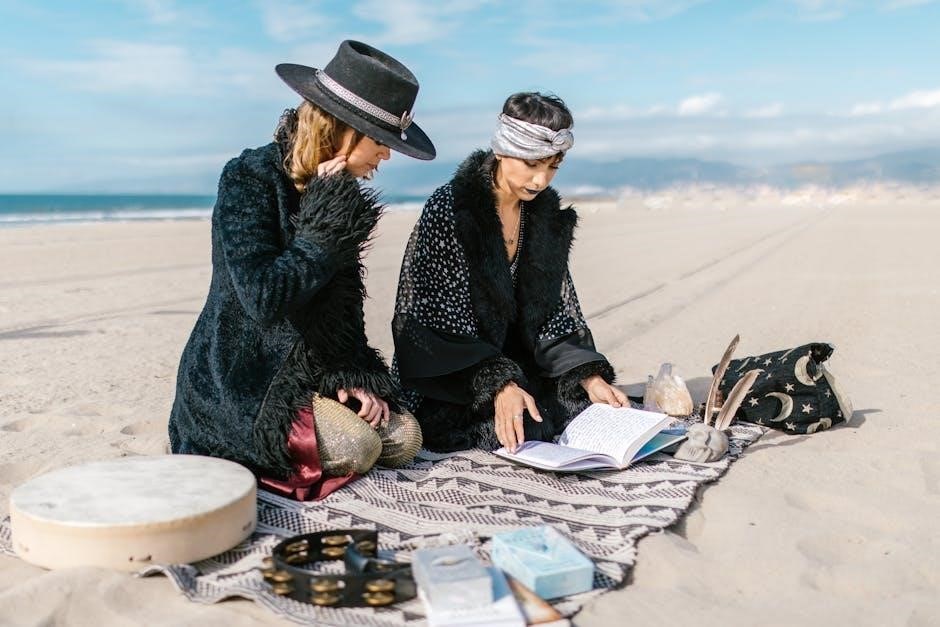
Explore New Zealand’s stunning landscapes at your own pace with self-guided cycling tours, offering flexibility and freedom to discover diverse terrains, from scenic trails to breathtaking coastal routes.
What Are Self-Guided Cycling Tours?
Self-guided cycling tours allow riders to explore New Zealand independently, following pre-planned routes without a group or guide. These tours offer flexibility, enabling cyclists to set their own pace and itinerary. Riders can choose trails that suit their skill level and interests, from easy scenic paths to challenging terrain. Logistics like accommodation and bike rentals are typically arranged in advance, providing a stress-free experience. This style of touring is ideal for those who value freedom and personalization while immersing themselves in New Zealand’s stunning landscapes and cultural highlights.
Why Choose New Zealand for a Self-Guided Cycling Tour?
New Zealand offers a unique combination of stunning landscapes, diverse terrain, and well-maintained cycle trails, making it a paradise for self-guided cycling tours. With its safe and scenic routes, riders can enjoy breathtaking views of mountains, forests, and coastlines. The country’s compact size and excellent infrastructure allow for easy navigation, while its welcoming culture and vibrant local communities enhance the experience. Whether you’re seeking adventure or relaxation, New Zealand’s natural beauty and cycling-friendly environment create an unforgettable journey for cyclists of all skill levels.

Popular Cycle Trails in New Zealand
New Zealand boasts iconic cycle trails like the Alps 2 Ocean, Otago Central Rail Trail, and Queenstown Trails, offering diverse landscapes and challenging yet scenic routes.
Alps 2 Ocean Cycle Trail
The Alps 2 Ocean Cycle Trail is a 316km journey from the Southern Alps to the Pacific Ocean, offering stunning views of rivers, lakes, and rural landscapes.
Starting near Christchurch, the trail winds through scenic valleys, hydro dams, and coastal routes, providing a mix of easy to moderate terrain for all cyclists.
This 6-day ride is part of New Zealand’s premier cycle trails, showcasing diverse natural beauty and charming local communities along the way.
Otago Central Rail Trail
The Otago Central Rail Trail is a 150km, 4–5 day journey through New Zealand’s South Island, offering a mix of scenic beauty and historical charm.
This easy-to-moderate trail follows a disused railway line, passing through tunnels, viaducts, and quaint rural towns.
Starting in Clyde and ending in Middlemarch, the trail showcases the region’s gold-mining history, rolling hills, and the vast Maniototo Plains.
Ideal for self-guided cycling tours, it provides a unique opportunity to explore New Zealand’s rugged landscapes and enjoy local hospitality at your own pace.
Queenstown Trails
Queenstown Trails are a must-visit for cyclists, offering a network of diverse routes that cater to all skill levels.
The Queenstown Trail itself is a 110km loop connecting Queenstown, Arrowtown, and Gibbston, with stunning views of the Southern Alps and Lake Wakatipu.
From leisurely rides along lakeshores to challenging climbs through vineyards, the trails provide a unique way to explore the region’s natural beauty.
Well-marked and maintained, these trails are perfect for self-guided tours, allowing riders to enjoy the freedom of cycling at their own pace.
Queenstown’s reputation as an adventure capital makes it an ideal base for combining cycling with other activities.
Clutha Gold Trails
The Clutha Gold Trails offer a scenic and historic cycling experience along the Clutha Mata-au River.
This 73km trail is part of the NZ Cycle Trails network and features a mix of easy to intermediate terrain.
Riders can enjoy stunning river views, native bush, and open tussock landscapes while exploring Central Otago’s heritage.
The trail is well-marked and suitable for all skill levels, making it a great option for self-guided tours.
With its rich history and breathtaking scenery, the Clutha Gold Trails provide a memorable adventure for cyclists.
Bike rentals and accommodations are readily available, allowing riders to plan their trip with ease.
This trail is a must-visit for those seeking a peaceful yet rewarding cycling experience in New Zealand.
Lake Dunstan Trail
The Lake Dunstan Trail is a 45km scenic cycling route that winds along the shores of Lake Dunstan in Central Otago.
Starting in Clyde and ending in Cromwell, the trail offers stunning views of the lake, surrounding mountains, and vineyards.
The relatively flat terrain with some gentle undulations makes it suitable for cyclists of all skill levels.
Riders can enjoy the peaceful atmosphere and picturesque landscapes while exploring this iconic New Zealand trail.
The trail is well-suited for self-guided tours, with amenities and bike rentals available in nearby towns.
It’s a perfect way to experience the natural beauty of the region at your own pace.
Roxburgh Gorge Trail
The Roxburgh Gorge Trail is a 34km section of the Clutha Gold Trails, offering a more challenging ride through rugged landscapes.
The trail follows the Clutha River, providing breathtaking views of deep gorges and scenic valleys.
With its mix of gravel paths and gentle climbs, it’s ideal for intermediate cyclists seeking adventure.
The trail’s remote nature immerses riders in untouched natural beauty, making it a highlight for self-guided tours.
Accommodation and bike rentals are available in nearby towns, ensuring a smooth and enjoyable experience.
This trail is a must-ride for those seeking a thrilling journey through New Zealand’s rugged heartland.

Planning Your Self-Guided Cycling Tour
Plan your self-guided cycling tour by tailoring itineraries, arranging bike rentals, and mapping routes to suit your skill level. Prepare gear, book accommodations, and seek local advice for a seamless adventure.
How to Choose the Right Trail for Your Skill Level
When selecting a trail, consider your fitness level, cycling experience, and comfort with terrain. Beginner-friendly trails like the Otago Central Rail Trail offer flat, smooth paths, while intermediate riders may enjoy the Lake Dunstan Trail’s mix of gravel and sealed roads. Advanced cyclists can tackle challenging routes like the Queenstown Trails, featuring steep climbs and technical descents. Research trail gradients, surface types, and distances to ensure a match with your abilities, ensuring a safe and enjoyable cycling experience in New Zealand’s diverse landscapes.
Creating a Personalized Itinerary

Designing a tailored itinerary for your self-guided cycling tour in New Zealand ensures a seamless and enjoyable experience. Start by assessing your fitness level, budget, and interests to select trails that align with your goals. Consider mixing cycling with activities like wine tasting in Marlborough or adventure sports in Queenstown. Plan daily distances to allow time for sightseeing and relaxation. Book accommodations in advance, especially during peak seasons, and pack essentials like maps and emergency supplies. Consulting with local cycling experts or tour operators can help craft a customized plan, ensuring your trip is both memorable and stress-free.
Booking Accommodation and Bike Rentals
Securing the right accommodation and bike rentals is crucial for a smooth self-guided cycling tour in New Zealand. Book lodging in advance, especially during peak seasons, to ensure availability near cycle trails. Choose from a range of options, including budget-friendly guesthouses and luxury retreats. For bike rentals, select a reputable provider offering high-quality bikes suited to the terrain. Many operators offer package deals combining accommodation and equipment rentals. Confirm bookings before your trip to avoid last-minute hassles and ensure a stress-free adventure.

Budgeting for Your Cycling Tour
Plan your budget wisely, considering bike rentals, accommodation, food, and activities. Average daily expenses range from $100 to $200, depending on your trail choices and comfort level.
Cost of Bike Rentals and Equipment
Bike rentals in New Zealand range from $40 to $100 NZD per day, depending on the type and quality of the bike. Mountain bikes and e-bikes tend to be pricier, while hybrid or road bikes are more affordable. Additional costs include helmets, panniers, and repair kits, which can add $10–$30 daily. Some rental companies offer package deals for multi-day rentals, reducing the overall cost. Booking equipment in advance is recommended to secure better rates and availability, especially during peak seasons.
Average Daily Expenses for Accommodation and Food
Average daily expenses for accommodation in New Zealand range from $80–$150 NZD for budget-friendly options like hostels or guesthouses. Mid-range hotels or lodges cost between $150–$250 NZD per night. Food expenses vary, with meals in cafes averaging $15–$25 NZD, while groceries for self-catering cost around $50–$70 NZD per day. Camping is a budget-friendly option, with campsite fees starting at $20 NZD per night; Planning meals and booking accommodations in advance can help reduce costs, ensuring a balanced budget for your cycling tour.
Ways to Save Money on Your Tour
Planning ahead is key to saving money on your cycling tour. Book accommodations and bike rentals in advance to secure better rates. Consider package deals that include both lodging and equipment. Opt for self-catering options to reduce food costs by preparing your own meals. Look for seasonal discounts or special offers, especially during off-peak seasons. Joining group tours occasionally can also lower expenses. Pack smart to avoid extra costs, such as bringing your own gear and using free navigation apps. Budgeting wisely ensures a cost-effective and enjoyable cycling experience.

Best Time to Cycle in New Zealand
New Zealand offers ideal cycling conditions during summer (Dec–Feb) and autumn (Mar–May), with pleasant weather and fewer crowds, making it perfect for self-guided tours.

Seasonal Weather Conditions
New Zealand’s seasonal weather plays a crucial role in planning self-guided cycling tours. Summer (Dec–Feb) offers warm, sunny conditions ideal for cycling, while autumn (Mar–May) provides mild temperatures and vibrant foliage. Winter (Jun–Aug) brings cooler weather, with potential rain and colder mornings, making it less favorable for road cycling. Spring (Sep–Nov) is a great time to enjoy blooming landscapes and fewer crowds. Understanding these seasons helps cyclists prepare for varying conditions, ensuring a safer and more enjoyable experience across New Zealand’s diverse trails.
Peak Tourist Seasons and Crowds
New Zealand’s peak tourist season, running from December to February, attracts large crowds to popular cycle trails like the Alps 2 Ocean and Queenstown Trails. These periods coincide with school holidays and summer vacations, making trails busier and accommodations harder to secure. Cyclists seeking quieter experiences may prefer visiting during the shoulder season (October to November or March to April), when the weather remains pleasant and crowds are smaller. Planning ahead and booking accommodations in advance is essential during peak times to ensure a smooth and enjoyable self-guided cycling tour.
Best Months for Cycling in North vs. South Island
The North Island is ideal for cycling year-round, but the best months are December to April, offering warm weather and dry conditions. The South Island, while cooler, shines from October to April, avoiding winter’s chill. Popular trails like the Timber Trail in the North and Alps 2 Ocean in the South are busiest during these periods. Plan accordingly, as peak months attract more cyclists. Both islands offer unique experiences, with the North’s lush forests and the South’s alpine scenery making every ride memorable.

Essential Items to Pack
Pack cycling gear, safety equipment, weather-appropriate clothing, navigation tools, and emergency supplies for a seamless self-guided cycling experience in New Zealand’s diverse landscapes.
Cycling Gear and Safety Equipment
A well-equipped bike is essential for a safe and enjoyable journey. Bring a sturdy helmet, bike lights, and a multi-tool for basic repairs. Carry a spare tube, tire levers, and a pump or CO2 cartridge. Reflective gear enhances visibility, while a first-aid kit and emergency whistle add extra safety. For off-road trails, consider knee and elbow pads. Ensure your bike is serviced before departure to handle New Zealand’s diverse terrains, from smooth paths to rugged tracks.
Clothing for Various Weather Conditions
New Zealand’s unpredictable weather demands versatile cycling clothing. Pack lightweight, breathable fabrics for warmer days and waterproof jackets for rain. Include thermal layers for chilly mornings and evenings, as well as moisture-wicking base layers to stay dry. Consider padded cycling shorts for comfort on long rides. Don’t forget gloves, a hat, and sunglasses for sun protection. Bright or reflective clothing enhances visibility, especially on roads. Proper footwear, such as cycling shoes, ensures efficiency and comfort. Layering allows you to adapt to changing conditions, keeping you comfortable throughout your tour.

Navigation Tools and Emergency Supplies
Essential for self-guided cycling tours, carry a GPS device or smartphone with offline maps to navigate New Zealand’s trails. A detailed paper map serves as a backup. Pack a first-aid kit, including bandages, antiseptic wipes, and pain relievers. A multi-tool or basic bike repair kit is vital for minor adjustments. Don’t forget a portable phone charger and a lightweight emergency blanket. Bring enough water, snacks, and sunscreen for remote sections. Ensure your phone has a GPS app like Maps.me or Trailforks preloaded for reliable navigation.
Cultural and Scenic Highlights
Discover New Zealand’s iconic landscapes, diverse wildlife, and rich cultural heritage while cycling through scenic trails, vineyards, and historic sites, blending adventure with cultural immersion.
Exploring New Zealand’s Natural Landscapes
New Zealand’s diverse natural beauty offers cyclists a unique adventure, with trails winding through stunning coastlines, pristine forests, and rugged mountain ranges. From the scenic coastal routes of the North Island to the dramatic landscapes of the South Island, riders can immerse themselves in untouched wilderness and breathtaking vistas. The Alps 2 Ocean Cycle Trail and Queenstown Trails showcase the country’s iconic landscapes, providing opportunities to spot native wildlife and experience the serene beauty of lakes, rivers, and valleys. Self-guided tours allow cyclists to explore these natural wonders at their own pace, creating unforgettable memories.
Experiencing Local Culture and Cuisine
Self-guided cycling tours in New Zealand offer a chance to immerse yourself in the country’s vibrant culture and savor its diverse cuisine. Along the trails, you can explore charming towns, visit local markets, and enjoy regional specialties like fresh seafood, artisan cheeses, and award-winning wines. The Marlborough region is renowned for its wine tasting tours, while Queenstown offers a mix of gourmet dining and casual eateries. Engaging with locals and experiencing their hospitality adds a rich cultural dimension to your cycling adventure, making it a truly unforgettable journey.
Historical Sites Along the Cycle Trails
Self-guided cycling tours in New Zealand allow you to pedal through history, with many trails passing by significant cultural and historical sites. The Otago Central Rail Trail, for instance, features preserved railway stations and bridges, offering insights into the region’s pioneering past. Similarly, the Roxburgh Gorge Trail showcases remnants of gold mining history, while other routes reveal Māori heritage sites and early European settlements. These landmarks add a fascinating cultural dimension to your cycling journey, connecting you to New Zealand’s rich and diverse history.

Combining Cycling with Other Activities
Enhance your cycling adventure by adding hiking, kayaking, or wine tasting to your itinerary. Explore New Zealand’s diverse landscapes and activities while maintaining a flexible pace.
Adding Hiking or Kayaking to Your Itinerary
Combine cycling with hiking or kayaking to experience New Zealand’s diverse landscapes fully. Hike through scenic trails like the Routeburn Track or kayak in pristine fjords like Milford Sound. These activities offer a break from cycling while immersing you in nature. Many trails, such as the Queenstown Trails, are near hiking routes, allowing seamless integration. Self-guided tours provide flexibility to explore at your own pace, making it easy to add these adventures. Enhance your journey by connecting with New Zealand’s stunning natural beauty on and off the bike.
Wine Tasting Tours in Marlborough Region
The Marlborough region is renowned for its world-class wines, particularly Sauvignon Blanc. A self-guided cycling tour offers the perfect opportunity to explore the Marlborough Wine Trail, with its flat, easy-to-follow routes. Visit local vineyards, sample premium wines, and enjoy scenic views of rolling vineyards. Many trails are designed with cyclists in mind, allowing you to combine biking with wine tasting effortlessly. This region’s wine culture and breathtaking landscapes make it a must-visit for cyclists who appreciate fine wine and natural beauty.
Adventure Activities in Queenstown
Queenstown, known as the adventure capital of the world, offers thrilling activities to complement your cycling tour. Enjoy bungee jumping, skydiving, or white-water rafting for an adrenaline rush. After biking the scenic Queenstown Trail, explore the stunning landscapes of Milford Sound or take a scenic gondola ride. The region’s vibrant atmosphere and diverse outdoor pursuits make it an ideal destination to combine cycling with other adventures, creating an unforgettable experience in New Zealand’s South Island.
Embark on a self-guided cycling adventure in New Zealand, where stunning landscapes and diverse trails offer freedom and create unforgettable memories for every cyclist.
Final Tips for a Successful Self-Guided Tour
Plan thoroughly, considering your fitness level and budget. Pack essentials like a reliable bike, safety gear, and navigation tools. Engage with local culture and cuisine for a richer experience. Stay flexible with your itinerary to adapt to weather or trail conditions. Pre-book accommodations during peak seasons to avoid shortages. Carry emergency supplies and a first-aid kit. Don’t rush—enjoy the scenic beauty and unique landscapes New Zealand offers. Lastly, ensure your bike is well-maintained to handle diverse terrains and long distances.
- Check weather forecasts regularly.
- Stay hydrated and carry snacks.
- Respect local environments and trails.
Why New Zealand is a Must-Visit for Cyclists
New Zealand offers a cyclist’s paradise with its diverse landscapes, well-maintained trails, and bike-friendly infrastructure. From the scenic Alps 2 Ocean Cycle Trail to the historic Otago Central Rail Trail, riders can explore stunning natural beauty at their own pace. The country’s compact size and varied terrain cater to all skill levels, while its safety and welcoming culture make it an ideal destination. Combine cycling with unique experiences like wine tasting in Marlborough or hiking in Milford Sound for an unforgettable adventure.
- Diverse and breathtaking landscapes.
- World-class cycle trails for all abilities.
- Perfect blend of nature, culture, and cuisine.




